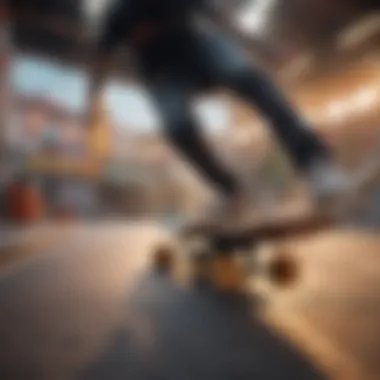How to Choose the Perfect Skateboard: A Complete Guide


Intro
Choosing the right skateboard is essential for both newcomers and seasoned riders. The experience you get from skating is heavily influenced by the skateboard you select. Understanding the various types of skateboards along with their components can provide you a clear advantage when making your decision.
Every rider has unique preferences and requirements, which means that a one-size-fits-all approach simply won’t work. This guide will address the key criteria you need to consider when selecting a skateboard, ensuring that your choice is aligned with your riding style and purpose.
As you progress through this article, detailed insights into equipment, techniques, safety, and the overall lifestyle surrounding skateboarding will equip you with a robust understanding of the topic. The objective here is to empower you to confidently navigate through the array of options available and make informed decisions.
Equipment and Gear
Overview of Essential Gear
In the world of skateboarding, your equipment goes beyond just the board. Safety gear is crucial for protecting yourself during your rides. Common items include helmets, knee pads, elbow pads, and wrist guards. A well-fitted helmet, for example, can be a lifeline when facing potential impacts.
Detailed Descriptions of Top Brands
When selecting gear, consider reputable brands known for quality and durability. Popular helmet brands like Bell and Protec offer models that catering to different levels of protection and comfort. For pads, brands such as Triple Eight and Sector 9 are frequently recommended.
Maintenance Tips
To get the most out of your skateboard gear, regular maintenance is essential. Always inspect your helmet for cracks or dents after a fall, and periodically check that your pads do not show signs of wear and tear. Upgrading to tech such as breathable fabrics and advanced cushioning can also elevate your riding experience.
Techniques and Training
Mastering Skills
Developing technical skills can transform your skating. Start with the basics and gradually move onto advanced tricks. Trying your hand at ollies or kickflips can enhance your control and develop your style.
Training Exercises
To improve your overall performance, incorporate exercises focused on strength, agility, and endurance. Simple routines like squats, lunges, and balance drills can substantially help you on the board.
"Success in skateboarding comes as much from determination and consistency as it does from skill."
Insight from Professionals
Engage in community events or training sessions led by professional athletes where valuable insights are shared. They often offer the best tips for honing tricky techniques while also providing motivation.
Safety and Risk Management
Importance of Safety Protocols
Skateboarding can be risky without proper safety measures. Always wear a helmet and protective gear. Understanding common hazards such as uneven ground, railings, or crowded areas can help minimize accidents.
Common Risks
A few common risks include falling, colliding with obstacles, or losing balance. Being aware of these can play a vital role in how you skate and the decisions you take during your rides.
Strategies for Mitigation
Develop a habit of assessing your surroundings before riding and stay alert. Moreover, knowing basic first aid can be beneficial in emergencies.
Events and Competitions
Upcoming Events
For those looking to immerse themselves in the culture, there are numerous competitions and events throughout the year. Attending these can not only provide inspiration but also a chance to connect with like-minded enthusiasts.
Profiles of Competitors
Identify local and international competitors. Observing their techniques can serve as an educational tool for your own practice.
Highlights from Key Competitions
Stay informed through platforms like Reddit, where discussions on recent events provide insights into innovations in skating and athlete performances.
Lifestyle and Community
Features on Skateboarding Culture
Skateboarding is about lifestyle as much it’s about sport. Engage with the community, explore skate parks, and share your experiences online. Participating in forums on platforms like Facebook can enhance your connection with fellow skateboarders.
Balancing with a Healthy Lifestyle
Finding a balance between your passion for skateboarding and maintaining a healthy lifestyle contributes significantly to mental well-being. Create schedules that allow time for practice while also managing rest and recovery.
By understanding and considering these aspects, you open up a world of possibilities in skateboarding. Each choice shapes your experience, making it crucial to approach your selection process thoughtfully.
Understanding Skateboard Types


Selecting the correct type of skateboard is a foundational step for anyone serious about skateboarding. Understanding skateboard types helps both novice and experienced riders align their choice with their intended use and skills. Different skateboard types cater to various skateboarding styles, environments, and riding intentions. This understanding can enhance the riding experience significantly by matching the right board with the right purpose.
Each skateboard type has its unique features and performance characteristics. Recognizing these distinctions is crucial for making informed decisions. For instance, a street skateboard may not perform well in downhill racing, while longboards excel in stability and distance. Therefore, knowing what you need helps in selecting a board that not only meets your requirements but also enhances your enjoyment.
Street Skateboards
Street skateboards are designed primarily for tricks and maneuverability in urban environments. They feature a narrow deck and a short wheelbase, allowing for quick turns and flips. The standard width typically ranges from 7.5 to 8.5 inches, which suits various foot sizes and riding styles. This type is great for riders interested in performing ollies, grinds, and other technical tricks.
Street boards are generally lightweight, making them easier to carry around. They have a poppy feel due to the concave shape of the deck and the hardness of the wheels, enhancing their responsiveness during tricks. Key considerations include the terrain and the type of tricks you plan to perform. If your interest lies in urban skating and street style tricks, then a street skateboard is likely the best fit for you.
Cruiser Skateboards
Cruiser skateboards provide versatility and a comfortable ride. These boards are larger and wider than street skateboards, with a typical width of 7.5 to 10 inches. They are designed for casual riding, commuting, or simply enjoying a smooth ride. Their wheels are usually softer, which allows for cushioning over rough terrain.
Cruisers often have a kicktail at the back for ease of turning and maneuvering. The shape tends to be more stable, making them suitable for beginners who are learning to skate. Cruisers are great for short distances and can be an excellent choice for those looking to enjoy a leisurely stroll through the neighborhood or ride to class.
Longboards
Longboards are characterized by their extended length, usually ranging from 33 to 60 inches. They offer excellent stability and are great for downhill rides, carving, and cruising. The larger size tends to provide better balance, making them suitable for commuters or those looking for long-distance rides.
The design typically includes larger wheels that roll smoothly over various surfaces. Longboards can be classified into various styles such as downhill, cruiser, and freestyle. Riders benefit from their smooth ride and control, allowing for a more leisurely experience. If your aim is to travel long distances efficiently, a longboard may be the right choice.
Vertical Skateboards
Vertical skateboards, or vert skateboards, are crafted for use in skate parks and ramps. They are similar to street skateboards but are built to handle the demands of vertical movements. These boards usually feature a wider deck and sturdier construction to withstand impacts from tricks and stunts.
The typical width is around 8.0 to 9.5 inches, and they are designed for performance during rides in bowls, half-pipes, and skate parks. The added stability and durability support various tricks, including aerials and grinds. For riders who enjoy ramp skating and intense trick performance, a vertical skateboard is optimal. Understanding these skateboard types allows you to better identify which board aligns best with your personal riding style and goals.
Evaluating Skateboard Components
Choosing the right skateboard goes beyond simply identifying the type of board. Evaluating skateboard components is crucial as they directly impact performance, durability, and your overall riding experience. Thorough understanding of each component helps in matching the skateboard specifications with individual preferences and riding styles.
Deck Material and Shape
The deck of a skateboard is its foundational piece, affecting its weight, flex, and durability. Most decks are made from use of maple, plywood, or more advanced materials like carbon fiber. Maple is the classic choice due to its balance of durability and flexibility. It's common in street and trick skateboards.
Furthermore, the shape of the deck plays an important role in its performance. Different shapes cater to different styles of riding:
- Standard popsicle shape: Favored for tricks and street skating, provides good balance.
- Cruiser shape: Wider and more extended, ideal for smooth rides and stability.
- Longboard shape: Specifically designed for downhill racing or cruising, providing better grip and control at higher speeds.
Choosing the right deck material and shape ensures that the board aligns with the skater's intended use, whether it's for tricks, commuting, or long-distance rides.
Trucks: Options and Importance
Trucks serve as the connection point between the wheels and the deck. Their design, material, and width are crucial for steering and stability. Typically made from aluminum, the quality of trucks can widely vary. Stronger trucks provide better handling and control, especially during complex tricks.
When considering trucks, the following factors are essential:
- Width: It should match the width of the deck for optimal stability.
- Height: Lower trucks offer better stability, while higher ones allow for larger wheels.
- Material: Aluminum is the standard, but there are also heavier materials that can withstand more impact.
Choosing appropriate trucks helps ensure smooth navigation and response during riding.
Wheels: Size and Hardness
Wheels are foundational for performance on different surfaces. Their size is measured in millimeters and determines the ride quality.
- Smaller Wheels (50-54 mm): Better for technical tricks and street skating. They allow for better control during landings.
- Medium Wheels (55-59 mm): A good compromise for street and cruising, offering decent speed and control.
- Larger Wheels (60+ mm): Suitable for cruising and rougher terrain as they provide a smoother ride.
Moreover, the hardness of the wheels, measured on the durometer scale, affects grip and durability:
- Softer Wheels (78A - 87A): Provide more grip and are forgiving on rough surfaces, ideal for cruising.
- Harder Wheels (88A - 101A): Offer more speed but may slide out easier, generally better for street tricks.
Bearings: Speed and Quality
The bearings provide a smooth ride by minimizing friction between the wheels and trucks. They have a significant impact on speed and performance. Typically rated with the ABEC system, higher ratings usually mean smoother and faster rides. However, it's crucial to consider other factors as well:
- Material: Steel and ceramic are common, with ceramic being more durable and resistant to damage.
- Seal Type: Rubber seals are easier to clean but may create more drag, while metal shields can increase durability.
Choosing high-quality bearings can greatly enhance your experience, providing longevity and better wheel performance.
In summary, evaluating the components of a skateboard should include detailed considerations about the deck, trucks, wheels, and bearings. Each piece contributes to the overall experience and performance, ensuring that the skateboard suits the rider's style and preferences.
Choosing the Right Size
Selecting the proper size skateboard greatly influences your riding ability, stability, and comfort. A correctly sized deck allows you to perform tricks more effectively and enhances overall control. Furthermore, size variations cater to individual needs and preferences, making it crucial for both beginners and experienced riders to understand these specifications.
Deck Width and Length
The deck width and length are fundamental dimensions that impact your skating experience. A wider deck provides better stability and is ideal for performing tricks, particularly for street skating. Conversely, a narrower deck allows for easier maneuverability, making it advantageous for cruising and transportation.
Typically, street skateboards range from 7.5 to 8.5 inches in width, while longboards can stretch up to 10 inches or more. The choice of width primarily depends on your personal style and the types of tricks you wish to execute. Additionally, the deck's length can affect your balance as well. A longer skateboard offers better stability for cruising but may limit your ability to perform intricate tricks.


Considerations:
- Stability: Wider decks provide more footing stability.
- Maneuverability: Narrow decks enable quicker turning movements.
- Type of Riding: Consider your primary use for the skateboard; tricks or cruising.
The length of the skateboard also varies, and it affects turning radius and control. Regular skateboards usually measure between 28 to 32 inches long as a standard, while longboards typically exceed that length for a smoother ride.
Rider Height and Weight Considerations
When selecting a skateboard size, your height and weight must be taken into account. A taller and heavier rider may require a larger deck to manage weight distribution effectively. If the skateboard is too small, it may become unbalanced, leading to difficulties in riding and potentially causing accidents.
Rider height influences grabbing control. Tall individuals generally gravitate towards wider boards for adequate foot placement. On the other hand, shorter riders may prefer narrower boards to facilitate ease of movement.
Guidelines for Matching Size:
- Rider Height: Choose a deck width that provides enough surface area for footing without overextending your reach.
- Rider Weight: Ensure your skateboard can support your weight without excessive flexing or vibrations.
To summarize, understanding the relationship between body dimensions and skateboard size is essential for enhancing your overall riding experience. Proper sizing minimizes risks and maximizes performance, creating a more enjoyable session.
"The right size skateboard is not just about dimensions; it significantly impacts your control, stability, and riding confidence."
By considering these factors, you position yourself to make informed decisions, ultimately aligning the skateboard choice with your unique riding profile.
Personal Riding Style and Preferences
The choice of skateboard significantly depends on an individual’s riding style and personal preferences. Understanding these factors is essential for selecting a skateboard that enhances the riding experience. Riders engage with skateboarding in numerous ways, and recognizing these variations can lead to better enjoyment and fewer frustrations. Personalized styles also correlate with skill levels, where different boards offer advantages for specific maneuvers or purposes.
Skill Level Assessment
Assessing one’s skill level is a foundational step in selecting the right skateboard. Beginners have different requirements compared to seasoned skateboarders. For instance, a beginner may benefit from a wider deck that provides greater stability, while intermediate or advanced riders often prefer narrower decks that facilitate tricks. Evaluating skill can include understanding comfort with balance, agility, and familiarity with various tricks.
- Beginners: Choose sturdy and wider boards to feel more secure when learning.
- Intermediate: Opt for a versatile board that allows for progression in skills and complexity.
- Advanced: Select specialized boards tailored for specific tricks or terrains.
Understanding your skill level can prevent potential injuries and improve confidence as you ride.
Purpose of Riding: Tricks vs Transportation
The purpose of riding is another critical element in determining the right skateboard. Riders often seek skateboarding for two main reasons: performing tricks or for daily transportation. Each purpose demands different skateboard characteristics.
- Tricks:
- Transportation:
- Boards designed for tricks generally have a shorter length and are more responsive.
- Lightweight material is preferable to facilitate easy flip and spin.
- Grip tape is essential to ensure secure footing when attempting aerials or grinds.
- For commuting, a larger deck and softer wheels may be more suitable to smooth out bumpy roads.
- Cruiser skateboards can provide comfort and stability over longer distances.
- A wider wheelbase is beneficial for better maneuverability in traffic.
By considering both your skill level and the intended use of the skateboard, riders can make informed decisions that better match their personal riding styles and preferences. With clear insight into what you want from skateboarding, choosing the right board becomes a more straightforward task.
Budget Considerations
Budget considerations play a crucial role when selecting a skateboard. This decision impacts the quality of equipment one can obtain, thus influencing the overall riding experience. It is essential to strike a balance between cost and quality to ensure durability and performance. Choosing a skateboard that fits within one’s financial limits yet meets personal needs is significant for satisfaction and safety.
Identifying Total Costs
When it comes to identifying total costs, it is important to look beyond the initial price of the skateboard itself. This includes examining additional expenses such as:
- Safety gear (helmets, pads)
- Maintenance tools (cleaning supplies, tools for repairs)
- Upgrades or replacement components as needed
- Any costs associated with specific riding locations (like parking fees at skateparks)
These elements can add up quickly. Therefore, understanding the complete financial picture is imperative before committing to a purchase. Being aware of potential ongoing costs helps to avoid future surprises which could lead to dissatisfaction.
Quality vs. Price: Finding a Balance
Finding a balance between quality and price is not always straightforward. Higher priced boards often incorporate better materials and construction methods, resulting in superior performance. However, this does not mean that lower-cost options lack quality. Many skateboard brands offer competitive models that serve beginners well.
Consider the following when weighing quality against price:
- Research reviews from other riders to gauge performance and durability
- Assess the specific riding style and needs to determine whether one should invest in premium brands or stick to budget-friendly choices
- Budget alignment: Ensure that any skateboard selected does not compromise financial stability
Purchasing the wrong skateboard due to cost considerations can result in increased costs later on, such as frequent repairs or replacements. Therefore, thorough examination in this area goes a long way in ensuring long-term satisfaction.
"A well-planned budget not only allows for immediate enjoyment but also sets the path for future enhancements and personal growth on a skateboard."
In summary, budget considerations encompass much more than the price tag of the skateboard. Paying attention to total costs, the quality vs. price equation, and maintaining a realistic budget are all essential steps in choosing the right board.
Where to Buy a Skateboard
Selecting the right place to purchase a skateboard is often overlooked by riders, yet it holds significant importance in ensuring satisfaction with your choice. The location influences not only the type of skateboard you can acquire but also the quality and overall experience. Consequently, understanding the various options available is vital for making an informed decision. The choice of location can affect how well the skateboard aligns with your riding style and preferences.
Local Skate Shops
Local skate shops provide a unique experience in the skateboard buying journey. These shops are often run by riders who have extensive knowledge about the sport. They can provide personalized recommendations based on your specific needs, ensuring you select a skateboard that matches your riding style.
Buying from a local shop allows you to physically inspect the skateboard. You can feel the deck, assess the trucks, and check the wheels directly. This hands-on approach is particularly beneficial for beginners, as they can receive guidance on the best fit for their needs. Moreover, local shops frequently have a community atmosphere, potentially creating connections with other skaters.


That said, the inventory may be limited compared to larger retailers. Prices might also be a little higher due to the specialized service. However, the value of expertise and community engagement often justifies these factors.
Online Retailers
Online retailers offer convenience and a wider selection of skateboards. Websites such as Amazon, Skate Warehouse, or Tactics provide numerous options, catering to varying skill levels and types of skating. This is especially beneficial when seeking specific brands or models that may not be available locally.
The advantage of shopping online is the ease of comparison. It's simple to evaluate prices across multiple platforms and read reviews from other riders. Many online shops also provide detailed descriptions and specifications for their products.
However, purchasing online does come with some risks. You cannot physically examine the skateboard before purchasing, which can lead to dissatisfaction. Depending on where you live, shipping costs might also add to the total expense. Additionally, the return process can be cumbersome if the skateboard does not meet expectations.
Second-Hand Options
Second-hand options present an economical choice for acquiring a skateboard. Websites like Craigslist, Facebook Marketplace, or even specialized skateboard forums can list great deals from other riders looking to sell their gear. This route allows you to save money, making it ideal for beginners who may not want to invest heavily at the start.
However, buying second-hand requires caution. It's crucial to inspect the skateboard thoroughly before finalizing the purchase. Look for signs of wear and check that the components are in good condition. If possible, try to ride the board briefly to ensure it meets your expectations.
In summary, where you buy your skateboard plays a critical role in your overall experience. Local skate shops offer personalized guidance, online retailers provide convenience and selection, while second-hand options can save you money. Each has its advantages and challenges, and the best choice will depend on your individual needs and circumstances.
It is crucial to align your skateboard choice with your riding style, budget, and personal preferences.
Maintenance and Upkeep
Maintaining your skateboard is essential for longevity and performance. Regular care not only prolongs the life of the components but also ensures safety while riding. A well-maintained skateboard enhances the riding experience. Riders should learn about various maintenance techniques and timings for replacing parts. This knowledge can prevent unnecessary accidents caused by malfunctioning gear.
Regular Cleaning Techniques
Cleaning your skateboard should be part of your routine. The accumulation of dirt, grime, and debris can interfere with performance and deteriorate the materials used in construction. Here are some effective cleaning techniques to keep your skateboard in optimal condition:
- Deck Care: Use a soft cloth and mild soap to clean the skateboard deck. Avoid using abrasive materials as they can damage the grip tape. Keeping the deck clean prevents unwanted slip.
- Wheels and Trucks: Detach the wheels and clean them with a suitable cleaner. Remove any hair or debris caught in the bearings. For the trucks, a damp cloth works well to keep them clean.
- Bearings Maintenance: Bearings need to be cleaned regularly. Use a bearing cleaner or household items like rubbing alcohol. Make sure they are completely dry before reattaching to avoid rust.
In summary, set a regular schedule for cleaning components. This practice maintains not only appearance but also functionality.
When to Replace Components
Understanding when to replace skateboard components is vital for maintaining safety and performance. Different parts have distinct lifespans based on usage and riding style. Here are practical signs that indicate it's time for replacement:
- Deck Integrity: Check for cracks or chips in the composite material. A damaged deck may break under pressure, posing a risk while riding.
- Wheels Wear: Look for flat spots or noticeable wear on the edges. Wheels should roll smoothly; if they don’t, it is time for new ones.
- Trucks: Inspect the trucks for bending or rust. A compromised truck affects stability and steering.
- Bearings: If the bearings sound gritty or are hard to spin, these components require replacement. Bearings are crucial for speed.
Remember, investing in good replacement parts maintains both your skateboard performance and safety.
Regular maintenance and timely replacements keep a skateboard in top shape for riders who push limits. This proactive approach to upkeep ensures that each ride remains enjoyable and safe.
Safety Gear and Accessories
Safety gear and accessories play a crucial role in skateboarding, ensuring that riders can enjoy their sport while minimizing risks of injury. When you engage in skateboarding, you enter a world filled with potential hazards. Protecting yourself is not just smart; it is essential. Skateboarding can lead to falls, collisions, or other unforeseen events. Thus, understanding the right safety gear and accessories is vital for both novice and seasoned riders. Investing in proper safety equipment can make a significant difference in your overall skateboarding experience by providing both confidence and physical protection.
Essential Safety Equipment
- Helmets: One of the most critical pieces of safety gear, helmets protect your head from impacts during accidents. A well-fitted helmet can reduce the risk of serious head injuries by absorbing impact forces. Choose a helmet that meets safety standards, such as CPSC or ASTM, ensuring that it has proper ventilation and a secure fit.
- Wrist Guards: These guards prevent wrist injuries by limiting the extent of bending and twisting. In the event of a fall, they can absorb some of the impact, reducing the likelihood of fractures or sprains. It is advisable to look for wrist guards that have adjustable straps and padding for comfort and effectiveness.
- Knee and Elbow Pads: Like wrist guards, knee and elbow pads protect against scrapes and fractures. They should be made of durable materials that can withstand falls without significant wear. For optimal protection, ensure that these pads fit snugly without slipping during use.
- Shoes: Select shoes with flat soles and good grip. Skate shoes often have reinforced areas to enhance durability. Proper footwear reduces the risk of slips and provides better control over your skateboard.
Selecting the right equipment tailored to your needs is essential. Ensure that equipment fits properly and is worn correctly to maximize effectiveness.
"Safety is not just a priority; it is a choice that every rider must make."
Additional Gear for Enhancing Experience
Apart from the basic safety gear, several additional accessories can improve your skateboarding experience:
- Impact Shorts: These padded shorts provide extra cushioning for your hips and tailbone. They offer protection during falls, especially for beginners still mastering tricks.
- Goggles or Sunglasses: Protects your eyes from debris and UV rays. Sunglasses can reduce glare and improve visibility in sunny conditions. Choose options that stay secure during movement.
- Protective Clothing: Wearing long sleeves and pants made from durable materials can shield your skin from abrasions and sun exposure. Opt for breathable fabrics to ensure comfort while skating.
- Reflective Gear: If you're skating at night or in low-light conditions, wearing reflective gear enhances visibility to others. This is especially important for safety when navigating urban areas.
Investing in these accessories not only increases safety levels but may also enhance performance for the rider, allowing for a more enjoyable skateboarding experience. Being well-equipped can help you focus on the thrill of skateboarding while minimizing the risks associated with it.
Trial and Experimentation
When selecting a skateboard, trial and experimentation play a crucial role. They allow riders to understand which type suits their style and needs best. Trying different skateboards enables them to feel the differences in components, like deck rigidity or wheel hardness. This hands-on approach helps to eliminate guesswork. Understanding comfort is as important as understanding specifications.
Testing Different Skateboards
Testing different skateboards before making a purchase is an effective way to identify the best fit. Many skate shops offer testing options, which can be invaluable. A rider can try various types, like street or longboards, and determine which handle best for their techniques.
When testing, consider evaluating the following factors:
- Deck Shape: A concave deck may provide more grip for tricks, while a flatter deck can offer more stability.
- Wheel Type: Softer wheels absorb shocks better, which helps when riding on rough surfaces.
- Trucks Size: Different widths affect handling. Testing can reveal personal preferences in maneuverability.
Riders should take their time during the testing phase. It is about finding what feels natural and enjoyable. This phase can reveal features or aspects not considered before, helping to inform the final decision.
Gathering Feedback from Peers
Feedback from peers is another effective way to assess options. Experienced skaters often have insights that can guide less experienced riders. Conversations can lead to discovering the advantages and limitations of specific boards.
Some ways to make the most of peer feedback include:
- Join Local Skate Groups: These groups often share experiences and opinions about different boards and setups.
- Watch Online Videos or Forums: Platforms like Reddit and Facebook host communities where advice is shared. Observing others with similar styles can help in understanding what works.
- Ask for Test Rides: Lenders among friends can provide a chance to try different boards quickly. When riding the same board, it becomes easier to assess comfort and performance directly.
By combining hands-on testing and community feedback, a rider can make a more informed decision. It solidifies understanding of both personal preference and community insights, leading to a well-rounded conclusion on their skateboard choice.
"Trial and experimentation are essential to evolving as a skateboarder, making sure the setup you choose complements your style and needs."















